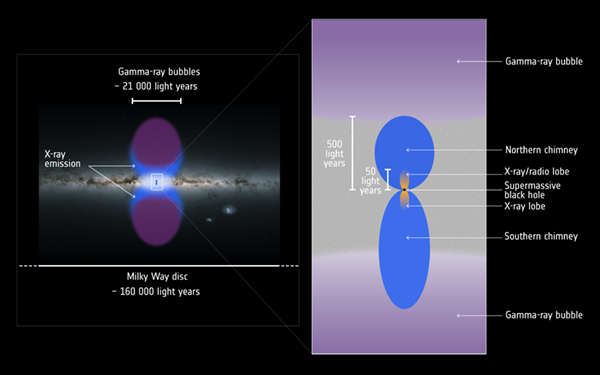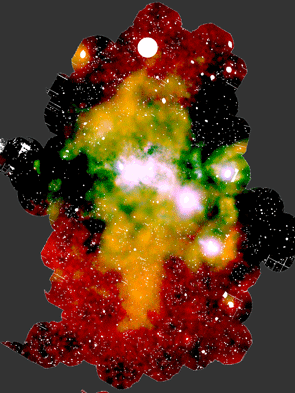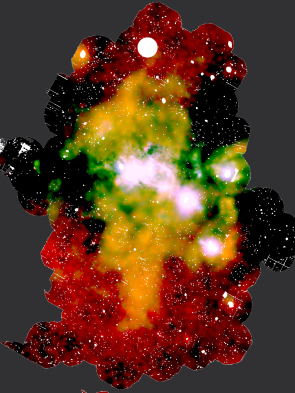Giant 'chimneys' vent X-rays from Milky Way's core
20 March 2019
By surveying the centre of our Galaxy, ESA's XMM-Newton has discovered two colossal 'chimneys' funneling material from the vicinity of the Milky Way's supermassive black hole into two huge cosmic bubbles. |
| XMM-Newton discovers galactic 'chimneys'. Credit: ESA/XMM-Newton/G. Ponti et al. 2019; ESA/Gaia/DPAC (Milky Way map); CC BY-SA 3.0 IGO |
The giant bubbles were discovered in 2010 by NASA's Fermi Gamma-ray Space Telescope: one stretches above the plane of the Milky Way galaxy and the other below, forming a shape akin to a colossal hourglass that spans about 50 000 light years – around half the diameter of the entire Galaxy. They can be thought of as giant 'burps' of material from the central regions of our Milky Way, where its central black hole, known as Sagittarius A*, resides.
Now, XMM-Newton has discovered two channels of hot, X-ray emitting material streaming outwards from Sagittarius A*, finally linking the immediate surroundings of the black hole and the bubbles together.
 |
| XMM-Newton's view of the Galactic centre. Credit: ESA/XMM-Newton/G. Ponti et al. 2019, Nature |
"We know that outflows and winds of material and energy emanating from a galaxy are crucial in sculpting and altering that galaxy's shape over time – they are key players in how galaxies and other structures form and evolve throughout the cosmos," says lead author Gabriele Ponti of the Max Planck Institute for Extraterrestrial Physics in Garching, Germany, and the National Institute for Astrophysics in Italy.
"Luckily, our Galaxy gives us a nearby laboratory to explore this in detail, and probe how material flows out into the space around us. We used data gathered by XMM-Newton between 2016 and 2018 to form the most extensive X-ray map ever made of the Milky Way's core."
This map revealed long channels of super-heated gas, each extending for hundreds of light years, streaming above and below the plane of the Milky Way. Scientists think that these act as a set of exhaust pipes through which energy and mass are transported from our Galaxy's heart out to the base of the bubbles, replenishing them with new material.
This finding clarifies how the activity occurring at the core of our home Galaxy, both present and past, is connected to the existence of larger structures around it. The outflow might be a remnant from our Galaxy's past, from a period when activity was far more prevalent and powerful, or it may prove that even 'quiescent' galaxies – those that host a relatively quiet supermassive black hole and moderate levels of star formation like the Milky Way – can boast huge, energetic outflows of material.
"The Milky Way is seen as a kind of prototype for a standard spiral galaxy," says co-author Mark Morris of the University of California, Los Angeles, USA. "In a sense, this finding sheds light on how all typical spiral galaxies – and their contents – may behave across the cosmos."
 |
| XMM-Newton's view of the Galactic centre. Credit: ESA/XMM-Newton/G. Ponti et al. 2019, Nature |
Despite its categorisation as quiescent on the cosmic scale of galactic activity, previous data from XMM-Newton have revealed that our Galaxy's core is still quite tumultuous and chaotic. Dying stars explode violently, throwing their material out into space; binary stars whirl around one another; and Sagittarius A*, a black hole as massive as four million Suns, lies in wait for incoming material to devour, later belching out radiation and energetic particles as it does so.
Cosmic behemoths such as Sagittarius A* – and those even more massive – hosted by galaxies across the cosmos will be explored in depth by upcoming X-ray observatories like ESA's Athena, the Advanced Telescope for High-Energy Astrophysics, scheduled for launch in 2031. Another future ESA mission, LISA, the Laser Interferometer Space Antenna, will search for gravitational waves released by the merger of supermassive black holes at the core of distant, merging galaxies.
Meanwhile, scientists are busy investigating these black holes with current missions like XMM-Newton.
"There's still a great deal to be done with XMM-Newton – the telescope could scan a significantly larger region of the Milky Way's core, which would help us to map the bubbles and hot gas surrounding our Galaxy as well as their connections to the other components of the Milky Way, and hopefully figure out how all of this is linked together," adds Gabriele. "Of course, we're also looking forward to Athena and the breakthrough it will enable."
Athena will combine extremely high-resolution X-ray spectroscopy with excellent imaging capabilities over wide areas of the sky, allowing scientists to probe the nature and movement of hot cosmic gas like never before.
"This outstanding result from XMM-Newton gives us an unprecedented view of what's really happening at the core of the Milky Way, and presents the most extensive X-ray map ever created of the entire central region," says ESA XMM-Newton Project Scientist Norbert Schartel.
"This is especially exciting in the context of our upcoming missions. XMM-Newton is paving the way for the future generation of X-ray observatories, opening up abundant opportunities for these powerful spacecraft to make substantial new discoveries about our Universe."
Notes for editors
"An X-ray Chimney extending hundreds of parsecs above and below the Galactic Centre" by G. Ponti et al. is published in the journal Nature.
XMM-Newton data were used in conjunction with archival data from NASA's Chandra X-Ray Observatory.
The bubbles stretching above and below the Milky Way's disc are known as Fermi bubbles, and were discovered in gamma-ray data gathered by NASA's Fermi Gamma-ray Space Telescope in 2010.
For more information, please contact:
Gabriele Ponti
Max Planck Institute for Extraterrestrial Physics, Germany
and INAF Brera Astronomical Observatory, Italy
Email: gabriele.ponti![]() inaf.it
inaf.it
Tel: +39 0272320425
Mark Morris
University of California, Los Angeles, USA
Email: morris![]() astro.ucla.edu
astro.ucla.edu
Tel: +1 310 825 3320
Norbert Schartel
XMM-Newton Project Scientist
European Space Agency
Email: norbert.schartel![]() sciops.esa.int
sciops.esa.int





